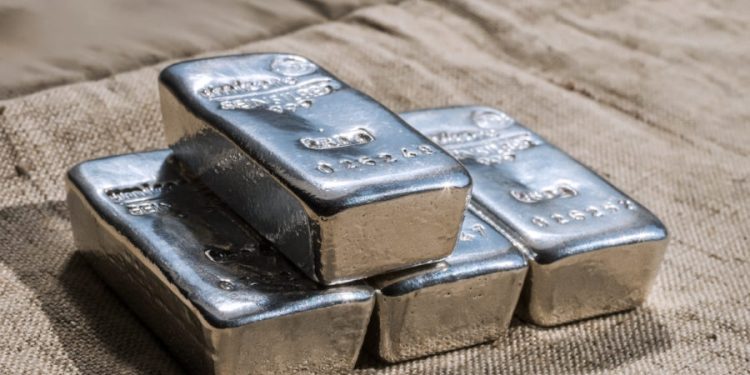Silver Traders Rush Bars to London as Historic Squeeze Rocks Market
The London silver market has been thrown into turmoil by a massive short squeeze, driving prices above $50 an ounce for only the second time in history and stirring memories of the billionaire Hunt brothers’ notorious attempt to corner the market in 1980.
Benchmark prices in London have soared to near-unprecedented levels over New York. Traders described a market where liquidity has almost entirely dried up, leaving anyone short spot silver struggling to source metal and forced to pay crippling borrowing costs to roll their positions to a later date.
And the squeeze has become so dramatic that some traders have rushed to book slots in the cargo holds of transatlantic flights for bulky silver bars — an expensive mode of transport typically reserved for more valuable gold — to profit off the massive premiums in London.
There’s no modern-day equivalent of the Hunt brothers trying to corner the market today, traders and analysts say, pointing instead to a combination of factors that have sent prices soaring. But the chaos of the past two days bears many similarities with the 1980 squeeze, and in some ways is even more extreme.
“I have seen nothing like it ever. What we are seeing in silver is entirely unprecedented,” said Anant Jatia, chief investment officer at Greenland Investment Management, a commodities hedge fund. “There is no liquidity available currently.”
For more than a century, London has been the heart of the precious metals markets, where global benchmark prices have been set by a small group of banks trading gold and silver bars held in one of a handful of vaults around the city. At the end of each day when positions are squared up, secure trucks shuttle between the vaults to deliver bullion to settle the trades.
The recent price surge has been driven in large part by a wave of investment into both gold and silver, spurred by fears of rising debt levels in the West and devaluation of currencies — a move that has accelerated amid the US government budget standoff and shutdown.
But the squeeze also reflects dynamics specific to silver, with market participants pointing to a sudden jump in demand from India in recent weeks, combined with a dwindling supply of available bars to trade and worries that the metal could be hit with US tariffs.
The silver market relies on the hundreds of millions of ounces of silver held in vaults in London to underpin liquidity. That stockpile has been steadily drained in recent years: first, by persistent deficits as mine production has failed to keep pace with demand from investors and industrial application such as solar panels; then, this year, by a rush to ship metal to the US amid fears of tariffs.
As a result, inventories of silver in London have fallen by a third since mid-2021. However, a large part of that is held by exchange-traded funds. The remaining “free float” of metal available to provide liquidity to the London market — mostly held by big banks — has dropped to just 200 million ounces, down 75% from a high of over 850 million ounces in mid-2019, according to Bloomberg calculations.
As a result, inventories of silver in London have fallen by a third since mid-2021. However, a large part of that is held by exchange-traded funds. The remaining “free float” of metal available to provide liquidity to the London market — mostly held by big banks — has dropped to just 200 million ounces, down 75% from a high of over 850 million ounces in mid-2019, according to Bloomberg calculations.
The London Bullion Market Association, a group representing the banks, refiners and logistics companies whose activity makes up the London market, said in a statement that it was “aware of tightness in the silver market and is actively monitoring the situation.”
Smashed records
Prices have smashed through multiple records in the past two days.
The silver auction in London – a daily price-setting event held since 1897 – on Friday traded above $50 for the first time ever. Spot prices in London shot to a premium as high as $3 over futures in New York, a level previously only seen in the midst of the Hunt brothers squeeze. The cost to borrow London silver overnight rose well over 100% on an annualized basis, which at least one market veteran said he believed was higher than anything seen during the 1980 squeeze.
In another sign of the stress in the market, bid-ask spreads for London silver blew out from their typical levels of around 3 cents an ounce to well over 20 cents an ounce.
“Banks don’t want to quote each other, so the quotes get extremely wide,” said Robert Gottlieb, a former precious metals trader and managing director at JPMorgan Chase & Co. “That’s creating this tremendous illiquidity.”
Bars on planes
In 1980, the market corner was broken by intervention from the exchanges. First Comex, then the Chicago Board of Trade — where the highest-ever recorded silver price of $52.50 an ounce was printed on Jan. 21, 1980 — imposed rules preventing traders from taking new positions and only allowing them to liquidate.
In today’s silver market, there is no such easy fix. Instead, the squeeze is likely to be resolved by more silver becoming available in the London market — either because ETF investors or other holders sell, or because traders are able to fly bars from other parts of the world to London in sufficient quantities to ease the tightness.
There are signs that is beginning to happen.
One executive at a logistics company said he had been receiving calls with growing urgency for the past week from customers seeking to take silver out of vaults linked to New York’s Comex and fly it to London. He estimated that traders were currently seeking to move some 15 million to 30 million ounces of silver from New York to London. On Friday, Comex saw its largest one-day withdrawal of silver in more than four years.
Others reckon that silver will start to flow out of China, where prices have also been trading at a discount to London in recent days, although volumes might be limited due to tightness in China itself.
“There’ll be a natural momentum for material to move back into London and hopefully things will normalize,” said Joseph Stefans, head of trading at MKS Pamp SA, one of the world’s biggest precious-metals refiners. “It’s just a question of mobilizing those balances that are sitting elsewhere in the world and moving them back to London.”
Still, some traders are reluctant to export silver from New York. The logistics are complicated, particularly amid fears the government shutdown may slow down customs processes, and the London squeeze means that even one day’s delay could be punishingly expensive. And there are still concerns that Trump could impose import tariffs on silver at the conclusion of a so-called Section 232 investigation into critical minerals, which includes silver.
“If there are no tariffs on silver that could ease that bid on metal in the US, and relieve some of the tightness in London,” said Amy Gower, a strategist at Morgan Stanley. “High prices can often solve these things in the short term.”








